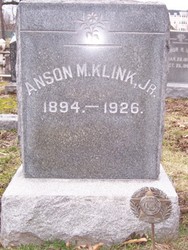Newport News Shipbuilding Housing - Anson Miller Klink
Introduction
Text-to-speech Audio
When we think about injured veterans, combat wounds tend to be what most people think. Yet because warfare involves so much more than just combat, many injuries were sustained far from any battlefield. By the early twentieth century, mechanized warfare required the skills of engineers, and Anson Miller Klink served and was wounded in this capacity.
Images
Klink's grave in Douglassville, Pennsylvania. His cause of death is unknown.

Newport News Shipbuilding & Dry Dock Company, circa 1922

Backstory and Context
Text-to-speech Audio
Whether due to the adjustments to civilian life, sustained injuries, or the side effects of Post Traumatic Stress Disorder, there are often scars of warfare that make changes in lifestyle a necessary part of life after service. But as with labor in many other sectors at the time, soldiers were at risk of injury without ever seeing a battlefield, or even being close to one. That was the case for Anson Klink Jr.
Anson Miller Klink was born in Douglassville, Pennsylvania in 1893 (according to the service questionnaire he filled out at the end of the war) or 1894 (according to his headstone). With no college education, he worked for a large construction company in Pottstown, PA as a steel worker prior to the war. He entered the service in July of 1918 and was assigned to work at the Anglo-American Tank Repair Unit at the Raritan Arsenal in New Jersey, likely due in part to his experience as a steel worker. He was never stationed abroad and never saw combat, but on January 27, 1919, after the war had technically ended, he was injured in an accident, and spent four months in the hospital. His right foot was crushed in a collision of two electric trucks, an injury that seems to have been permanent - his service in the military ended on the same day he left the hospital, the 29th of May in 1919.
As Klink wrote in his own questionnaire, "My injury would not permit me to follow old occupation. Secured position in Ship yard and worked my way up by my own initiative." Despite this seeming to have been his defining experience of military service, by the time of his writing in the questionnaire in 1921, he still said that he "enjoyed" his time in the service. By 1921, he was working in the Quarterman Rigging Department at Newport News Shipbuilding and Dry Dock Company, one of the largest employers in the city at the time. The exact nature of his work is unknown.
Despite the otherwise booming US economy of the 1920s, the shipbuilding industry was undergoing a period of collapse, due largely in part to the end of the war sinking demand for new ships, and would not return until 1926. Klink died in 1926, at only 32. He was still living in Newport News at the time, but was buried in his hometown of Douglassville. The cause of early death was not noted in any obituary, though his wife Dorothy and their two children are mentioned. Whether or not Klink was able to maintain a job in a hard, competitive economy is not known, and his cause of death only further raises more questions.
The location chosen was his noted place of residence in the questionnaire - though the exact spot is now a parking lot, on just the other side of the street, there can be seen company housing for NNS & DDC today, which likely resembles the kind of housing Klink would have had in the 1920s.
Sources
Erikson, Mark St. John. "Landmark 1926 launch marked Newport News shipyard's survival." Daily Press, March 19, 2016. https://www.dailypress.com/history/dp-nws-landmark-shipyard-launch-20160319-story.html
"Anson M. Klink." (Obituary) Reading Times, Reading, Pennsylvania. June 30, 1926.
Klink, Anson Miller. War History Commission State of Virginia Military Service Record. Library of Virginia, Virginia War History Commission.
https://www.findagrave.com/memorial/25216264/anson-m.-klink/photo
https://catalogs.marinersmuseum.org/object/CL17736
